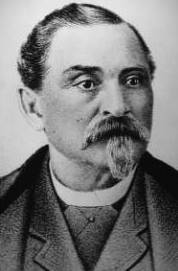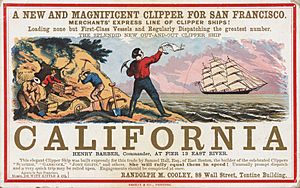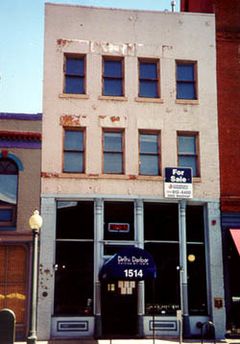Barney Ford facts for kids
Quick facts for kids
Barney Lancelot Ford
|
|
|---|---|
 |
|
| Born |
Barney Lancelot Ford
January 22, 1822 Virginia, US
|
| Died | December 22, 1902 Denver, Colorado, US
|
| Resting place | Riverside Cemetery (Denver, Colorado) |
| Monuments |
|
| Nationality | American |
| Known for | Colorado businessman and civil-rights pioneer |
| Spouse(s) | Julia A. Lyon |
Barney Lancelot Ford (born January 22, 1822 – died December 22, 1902) was an amazing American who started as an escaped slave. He became a very successful businessman and a leader in civil rights in Colorado. Barney Ford worked hard to build new businesses. He faced many challenges like racism, wars, fires, and tricky business partners.
He loved to open barbershops, restaurants, and hotels. He also put his money into mines. Ford was a champion for civil rights and believed strongly in education for everyone. He even helped people escape slavery through the Underground Railroad. He fought for the right for all men to vote. He successfully argued that Colorado should not become a state until all males could vote. He also helped create school programs and buildings.
As a teenager, Ford traveled across the Mississippi River. He moved animals, goods, and people across state lines. As an adult, he often moved for business. He worked in cities like Chicago, Breckenridge, Denver, Cheyenne, and San Francisco. He even had businesses in Nicaragua.
Barney Ford was honored for his work. He was inducted into the Colorado Black Hall of Fame. He also joined the Colorado Business Hall of Fame. A beautiful stained-glass portrait of him is in the House Chamber of the Colorado State Capitol.
Contents
Early Life and Family
Barney Ford was born on January 22, 1822, in Stafford, Virginia. His mother, Phoebe, was an enslaved woman. His father was a white plantation owner. Barney grew up on a plantation in South Carolina. His mother risked a lot to make sure he learned to read and write. An enslaved man might have taught him.
Ford ran away from slavery when he was about 17 or 18 years old. By 1848, he had several jobs. For four years, he drove mules and hogs from Kentucky to Columbus, Georgia. Then he worked on a cotton boat for three years. He was a second steward on a boat from Columbus, Georgia, to Apolachicola, Florida. From 1846 to 1848, he worked on a Mississippi passenger steamer. This boat traveled between St. Louis, Louisville, and New Orleans. People from the Underground Railroad helped him along the way.
When he was young, he was known only as Barney. Later, he chose the full name Barney Lancelot Ford. He learned to read and write on his own. This happened either on his way to Chicago or after he arrived there. He became friends with people in Chicago who were against slavery.
In 1849, he married Julia Lyon or Lyoni in Chicago. They had two children, a son named Lewis Napoleon and a daughter named Sadie. Barney Ford passed away in 1902. Julia and Barney Ford are buried at Riverside Cemetery in Denver.
Building a Business Empire
Barney Ford learned how to cut and style hair. He worked as a barber in Chicago. In 1851, he and his wife decided to try their luck in the California Gold Rush. To avoid slave hunters, they planned to sail from New York City. They would go around Cape Horn and then north to California.
They sailed from New York. When they reached Greytown (now San Juan de Nicaragua), they decided to stay. They opened a hotel for Americans called the United States Hotel and Restaurant. They also started other businesses. His businesses did very well. But his hotel was destroyed during Nicaragua's war for independence. It was also bombed by an American Naval ship. Other businesses were ruined by storms or fires.
Ford then worked as a steward on a ship owned by Cornelius Vanderbilt. Vanderbilt was a famous businessman. He was creating a travel route between the Atlantic and Pacific Oceans through Nicaragua. This route used steamboats on the San Juan River and Lake Nicaragua. It was an alternative to the Panama Canal Railway route.
Slavery was brought back in Nicaragua. So, the Fords returned to Chicago. Ford ran a livery stable there. It was also a secret station for the Underground Railroad until 1860.
Ford joined the Pike's Peak Gold Rush in 1860. He tried to claim land in Breckenridge, Colorado. But local people threatened him and chased him away. He found out that as an African American, he could not officially claim land. He hired a lawyer to do it for him. But the lawyer cheated the Fords instead.
Barney and Julia went to Denver. They opened a barbershop and a restaurant on Blake Street. In 1862, he bought the building for $673. The Great Fire of April 1863 swept through Denver's business area. It destroyed his barbershop.
He rebuilt with a new, larger building. It held the People's Restaurant, a bar, and a barbershop. These businesses opened on August 16, 1863. Within 90 days, he paid off a $9,000 loan from Kountze Brothers Bank. The next year, he earned $4,673. This made him the fourteenth-highest earner in the city. By 1865, Ford was nicknamed "Black Baron of Colorado." He made money from smart investments in mines, and from his successful restaurants and barbershop. Until 1871, he had many profitable businesses. But he also faced disasters like fires and bad business partners.
By the 1870s, Ford was one of the richest men in Colorado. In 1872, he bought the Sargent Hotel in downtown Denver. He renamed it Ford's Hotel.
He built two Inter-Ocean Hotels. The first was in Denver at Blake and 16th Street. It was finished in 1874. It was designed in the Second Empire style. It was the best hotel in the city at that time. He leased it to Howard C. Chapin. The second Inter-Ocean Hotel was built in Cheyenne, Wyoming. After this, he faced money problems. Losses from that hotel and other businesses, plus the Panic of 1873, led to bankruptcy.
The Fords lived in San Francisco for a while. There, he learned about "chop houses." This inspired him to move to Breckenridge, Colorado. In 1880, he opened Ford's Restaurant and Chop House. There was a silver boom in Breckenridge then. Ford regained his wealth from the restaurant and his investments. In 1882, he built a five-room house. This house later became the Barney Ford House Museum. In 1890, Ford and his wife returned to Denver. He managed his investments in "first-class income paying property."
Fighting for Rights and Education
Barney Ford was famous for his strong belief that African Americans should be free from slavery and racism. From his first days of freedom in Chicago, he helped people traveling on the Underground Railroad. He ran a station in Chicago in the 1850s. The goal was to help former slaves reach Canada, where they could live free.
He became friends with Henry O. Wagoner, a journalist. Wagoner worked for Frederick Douglass' newspaper, The North Star. With Wagoner, Ford started a school for African American children. In 1866, they also began evening classes for adults. They fought for equal education for all people in Colorado.
When Colorado wanted to become a state in 1865, Ford went to Washington, D.C.. He argued that Colorado should not be admitted until all males could vote. He traveled to Washington again to fight for the Fifteenth Amendment to the United States Constitution. This amendment would give African Americans the right to vote. After it passed in 1870, he supported Colorado becoming a state. Colorado officially became a state in 1876.
He was the first African American nominated to the Colorado Territory legislature. He served one term in the Colorado General Assembly. In 1872, he was the first black man in Colorado to serve on a federal grand jury.
Ford was a member of the Republican Election Commission. He was very important in helping fellow Republican Joseph H. Stuart get elected. Stuart introduced a bill on January 19, 1895. It aimed to "prohibit discrimination in any hotel, restaurant, theater, or other place of public accommodation." This bill, House Bill 175, became a law on April 9.
Legacy and Honors
Barney Ford's important contributions to Colorado are honored. There is a stained-glass window of him in the State Capitol building.
He was inducted into the Colorado Business Hall of Fame in 1992. In 2018, he joined the Colorado Tourism Hall of Fame.
In 2021, Rocky Mountain PBS produced a documentary called "Colorado Experience: Mr. Barney Ford."
Several places are named after him:
- A school on Maxwell Place in Denver's Montbello neighborhood.
- A hill in Breckenridge where Ford once tried to claim land for mining. He was chased away from it. In 1964, it was named Barney Ford Hill.
- A tall residential building called Barney Ford Heights.
See also







